How to Create Folders in Gmail and Organize Your Inbox Efficiently
Struggling with a cluttered Gmail inbox? Discover proven strategies to declutter and efficiently organize your emails using Gmail's innovative labeling system. This guide reveals how to create folders in under a minute, transforming your email management and boosting productivity by up to 40%.
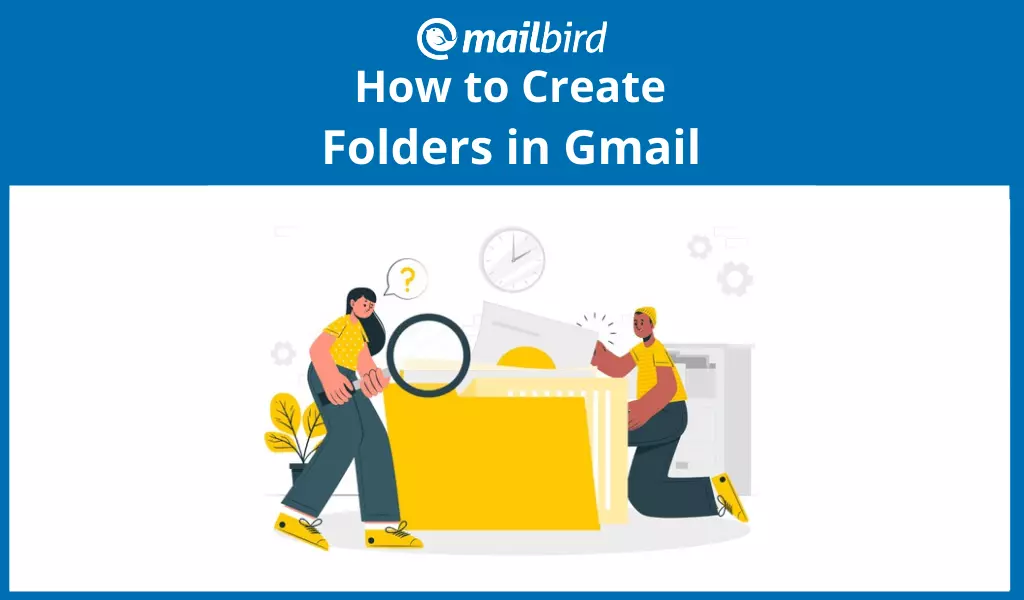
Article Updates
- September 2025:"Updated with the latest information and added three new questions to the FAQ for better user understanding."
- August 2025: Updated with a comprehensive FAQ section to address common reader questions and provide additional clarity on key topics covered in this article.
If you're struggling with a cluttered inbox and find it incredibly challenging to locate important emails among promotional messages and notifications, we will provide you with proven solutions! First, read our four simple steps for getting rid of unnecessary emails. Then, continue with this article to discover how to sort your emails more efficiently using Gmail's organizational features.
Gmail allows you to structure your inbox, organize your emails, and create a systematic approach to email management. According to Google's official Gmail documentation, the labeling system provides users with powerful organizational capabilities that go beyond traditional folder structures. In this comprehensive guide, we'll demonstrate how to create folders in Gmail and transform your email management experience through strategic organization.
How to Create Folders in Gmail in Less Than a Minute
All Gmail accounts come with a standard set of system labels, including Inbox, Spam, Sent, and others. Having a single inbox where business communications, personal correspondence, and subscription emails are combined creates significant challenges for email productivity. Google Workspace research indicates that organized email systems can improve productivity by up to 40% for knowledge workers.
Gmail has developed an innovative labeling system that allows you to organize your emails and transform your inbox from a cluttered collection into a well-structured communication hub. Unlike other email services that use traditional folder hierarchies, Gmail employs labels that function as dynamic tags. This approach enables you to group your emails into multiple categories simultaneously, providing greater flexibility than conventional folder systems.
The labeling mechanism works similarly to applying colored tags to physical documents—you mark individual messages to make them easily identifiable and searchable. According to Gmail's API documentation, you can assign multiple labels to each email, creating a sophisticated categorization system. It is crucial to understand that Gmail doesn't create duplicate copies of labeled emails. When you delete an email from one label view, it disappears entirely from your account.
Using Gmail's labeling system is particularly effective for long-term email storage while maintaining a clean primary inbox. Google's email management guidelines recommend this approach for users handling high email volumes. Here is how you can create and implement Gmail's folder-like labels.
How to Create Folders in Gmail in 30 Seconds
Here is the most efficient method to create labels in your Gmail account, tested across multiple Gmail configurations.
First, ensure you're signed in to your Google account and open your Gmail interface. Navigate to the left sidebar of your inbox and locate the More button beneath your primary navigation options.
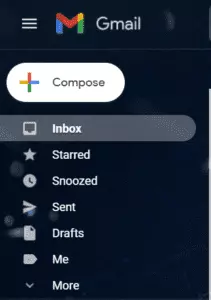
Click on the More button and scroll through the expanded menu until you find the Create new label option. Click on it, and Gmail will display a label creation dialog box.
Simply enter your desired label name in the text field, click Create, and your new organizational label is ready for use.
You will notice an additional option in the dialog called Nest label under. This feature allows you to create hierarchical subfolder structures within your labeling system.
For example, if you want to organize financial documents from your bank, you would first create a parent label named Financial Records. You can then create nested sublabels such as January Statements, February Statements, and so forth to organize documents chronologically underneath the main category.
This streamlined invoice processing approach ensures easy retrieval and maintains excellent organizational structure, making expense tracking and financial record management significantly more efficient.
This represents the fastest method for creating Gmail labels. However, there are additional approaches available for users who prefer alternative workflows.
Create and Manage Labels from the Settings Menu
Here is an alternative method for creating and managing Gmail labels from your desktop computer, whether you're using Windows or Mac.
First, open your Gmail interface. Locate the gear icon in the upper right-hand corner of your screen and click on it. From the dropdown menu, select See all settings.
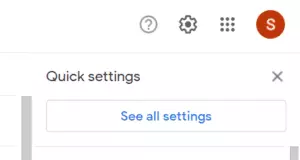
Alternatively, you can access label management through the sidebar method. Navigate to the left sidebar where your Inbox and Sent folders are located, scroll to the bottom of the navigation panel, and click on Manage labels.
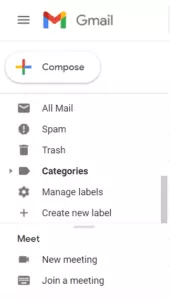
Both navigation methods will direct you to Gmail's comprehensive label management interface.
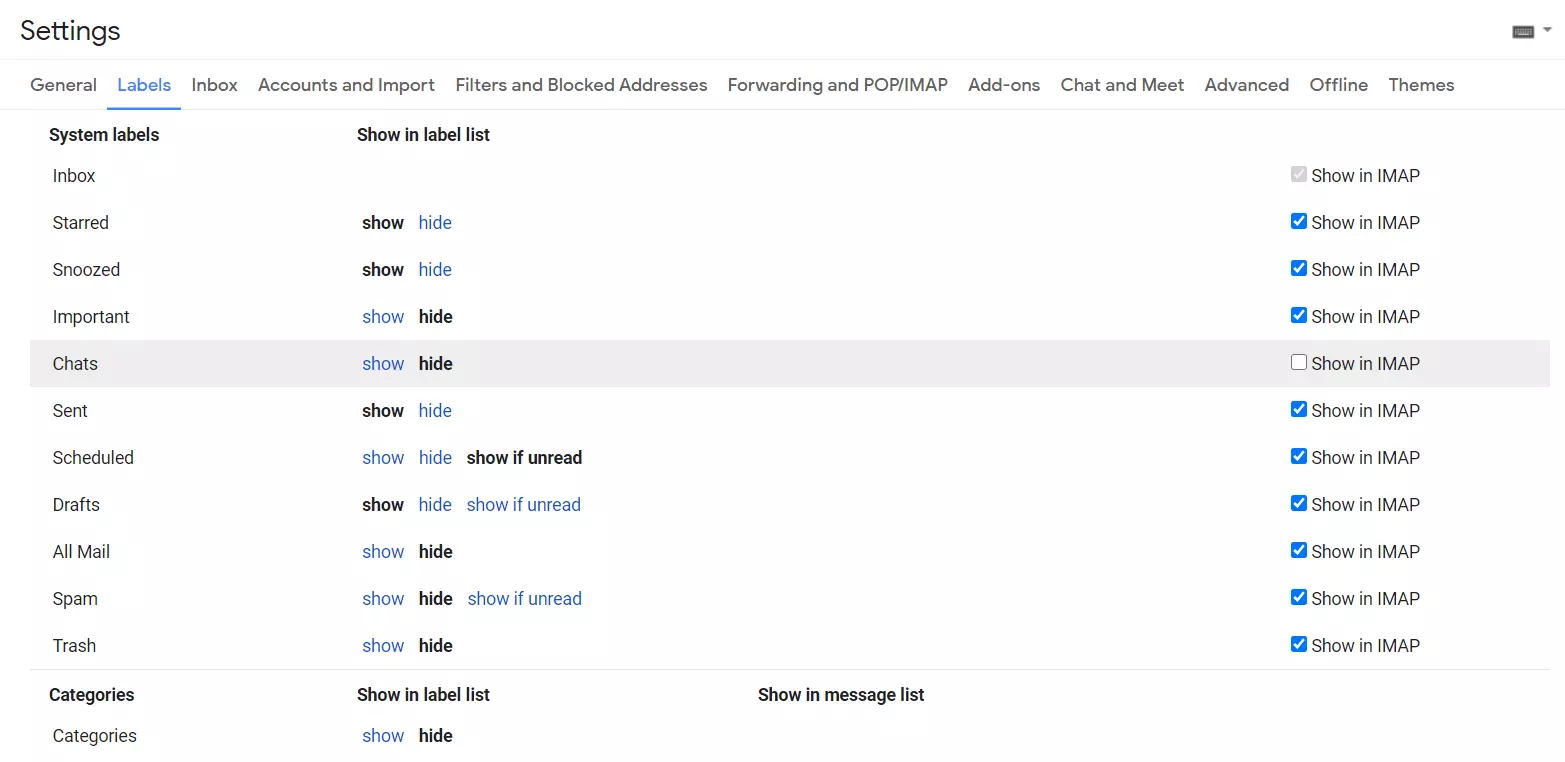
Click on the Labels tab at the top of the settings page and scroll down until you locate the Labels subsection.
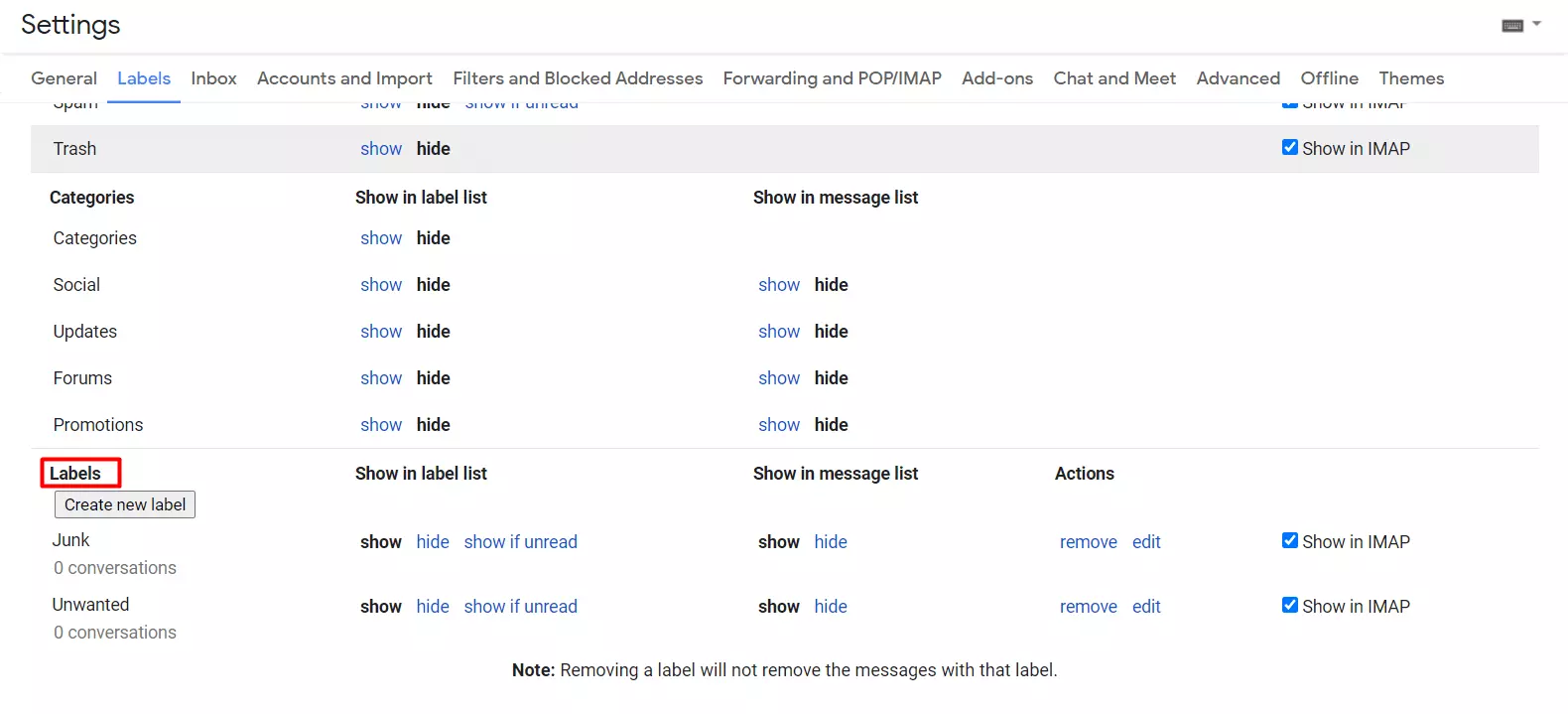
Directly below the subsection heading, you'll find a Create new label button. Click on it to open the label creation dialog.

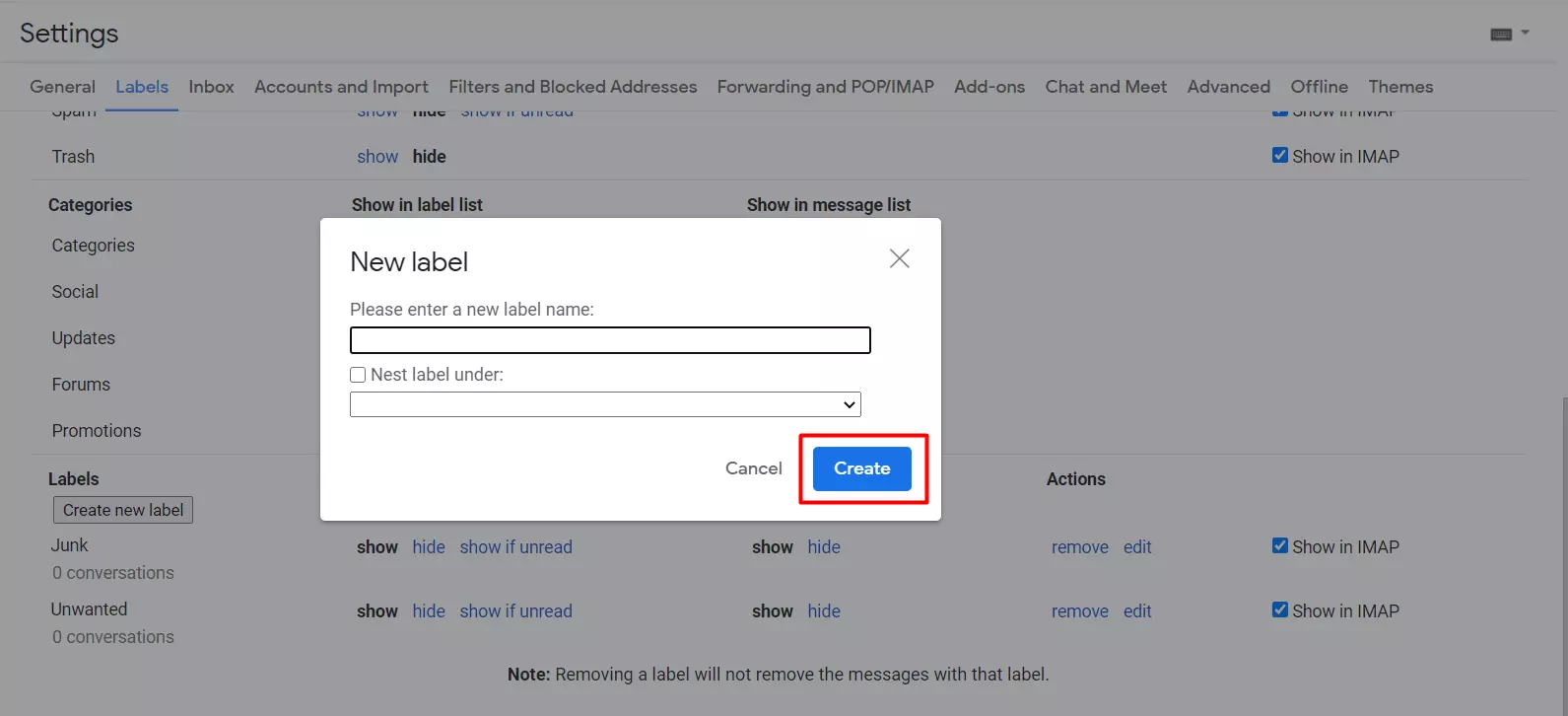
This covers the essential knowledge for creating organizational labels in Gmail. Now that we've established the creation process, let's explore how to effectively organize emails using these newly created labels.
How to Organize Emails into Folders in Gmail
Once you've created your labeling system, it's time to start sorting your emails and applying labels to conversations. Google's email organization best practices recommend several efficient approaches for email categorization.
Add Labels from an Email
Navigate to your Inbox and open an email message you'd like to categorize with a specific label. After reading or responding to the email, locate the action toolbar at the top of the message and click on the folder icon with an arrow.
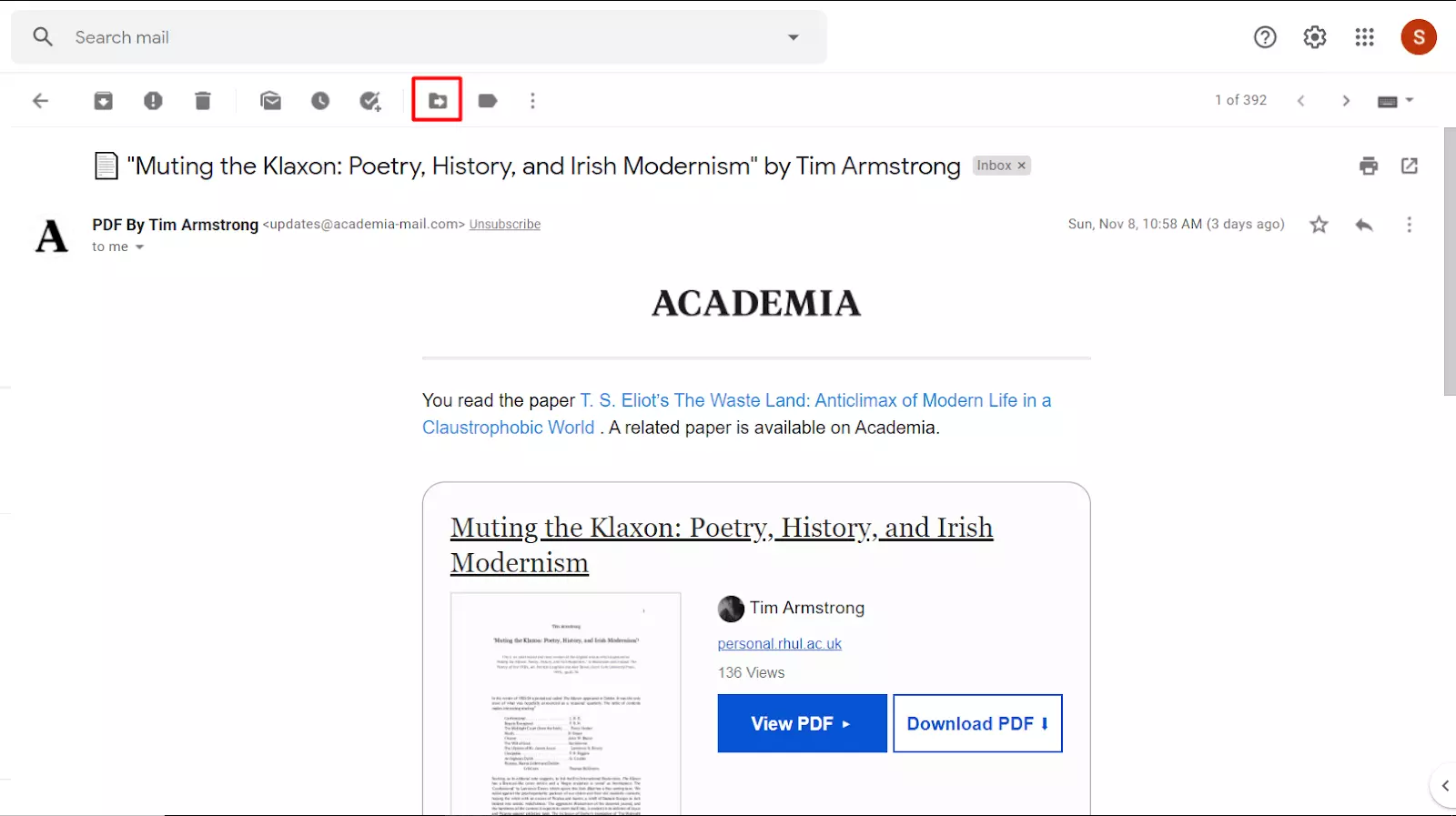
This folder icon represents the Move To function. Clicking it will display a dropdown menu containing all your existing labels.
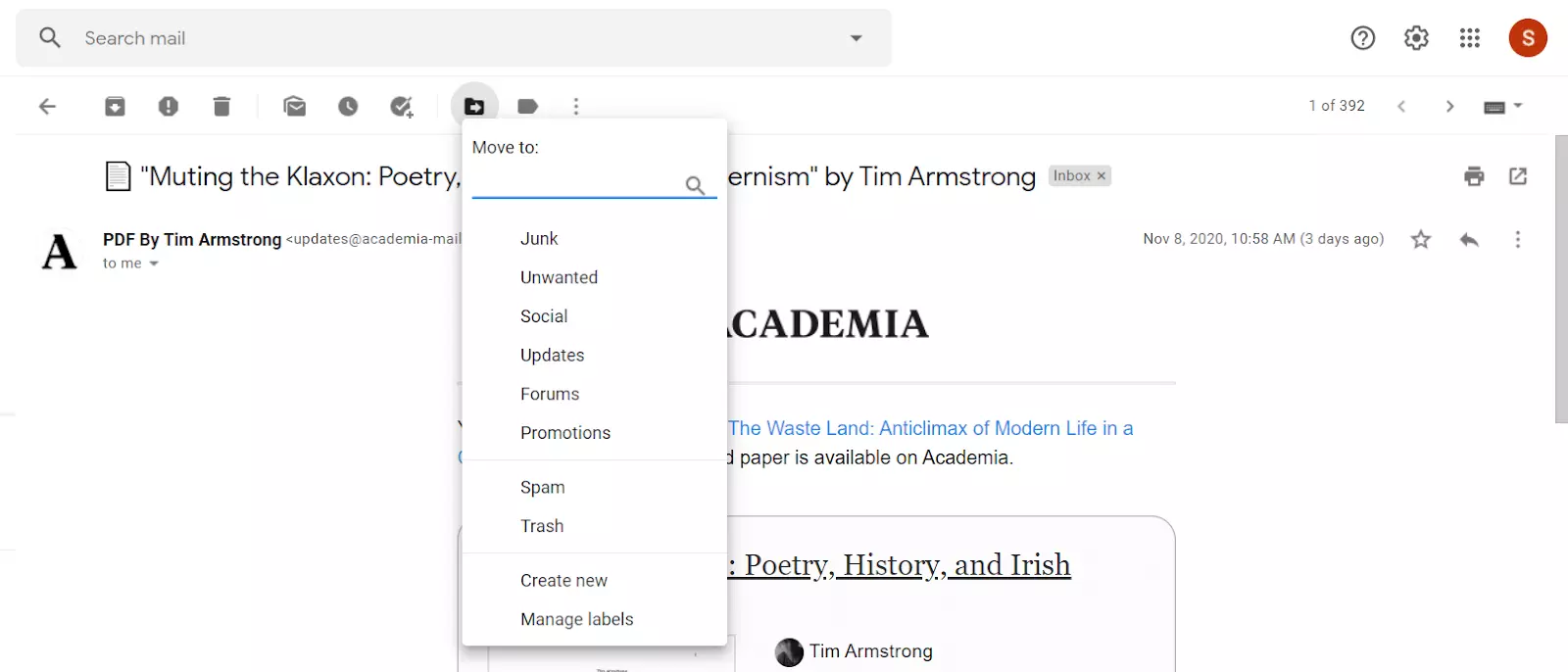
Select the appropriate label from the list. This action will remove the email from your primary inbox and transfer it to the designated label folder. If you prefer to keep the email visible in your inbox while also categorizing it, use the Labels button located adjacent to the Move To option.
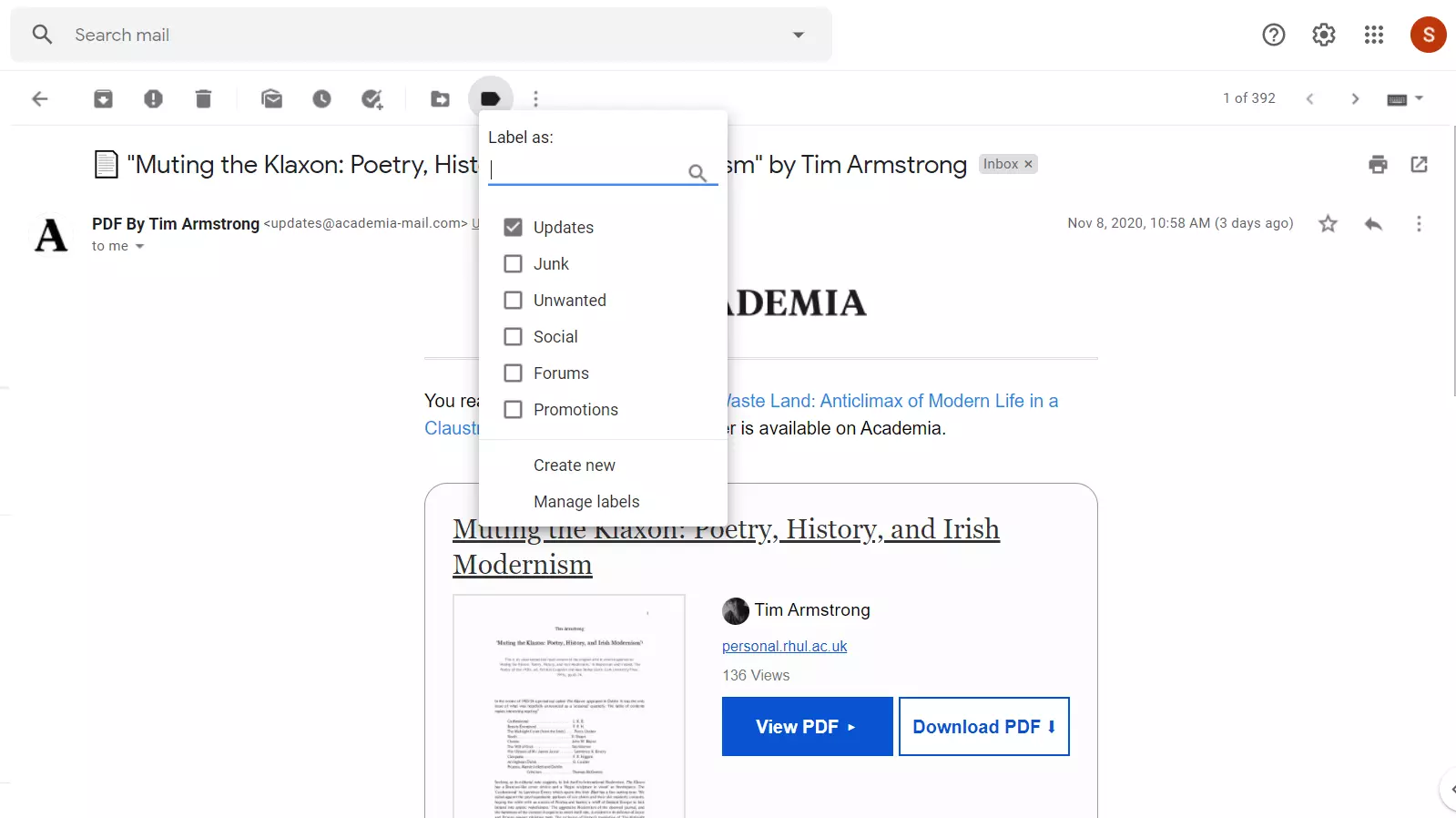
Using the Labels function allows you to maintain the email in your primary inbox while simultaneously adding categorical labels for organization purposes.
Pro tip: You can apply labels to multiple messages simultaneously by selecting multiple emails from your inbox using the checkboxes, then clicking the Labels button to categorize them in bulk.
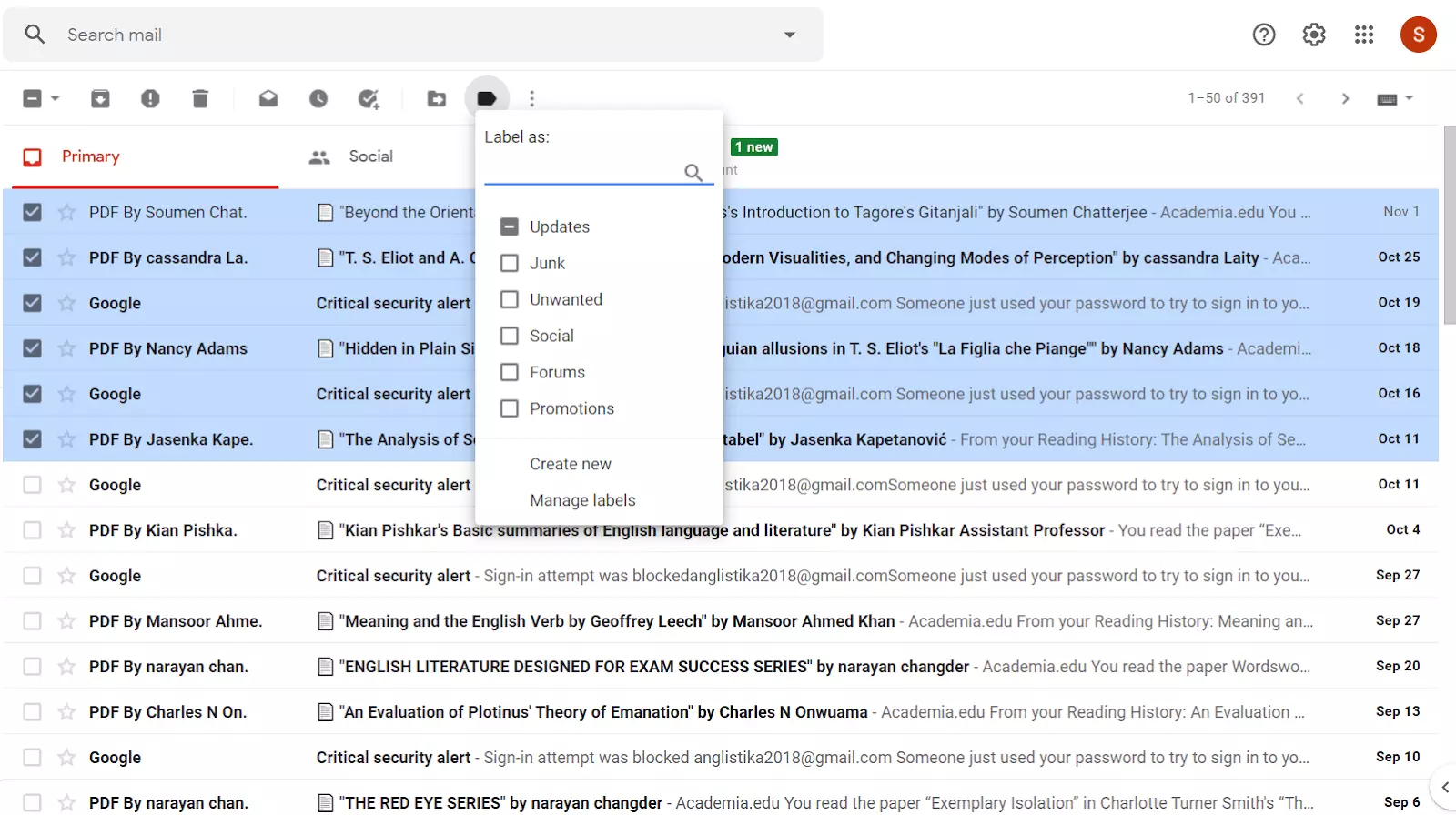
Add Labels by Using a Filter
Gmail's filtering system provides automated labeling capabilities based on specific search criteria. According to Google's advanced Gmail features documentation, filters can significantly reduce manual email organization time.
To create an automated labeling filter, open the Gmail search bar and enter your desired criteria (such as emails from a specific sender address, containing certain keywords, or meeting other parameters).
After defining your search criteria, click the Create filter button located in the bottom right corner of the search options. In the filter actions dialog, check Apply to matching conversations to affect existing emails. Then, select Apply the label and choose which labels you want to assign automatically. Click Create filter to activate the automation.
This automated system will apply your specified labels to all conversations matching your criteria and will continue to categorize future incoming emails that meet the same parameters.
Add Labels by Creating Subfolders
When you access the Create new label dialog, the Nest label under option enables hierarchical subfolder creation within your organizational system.
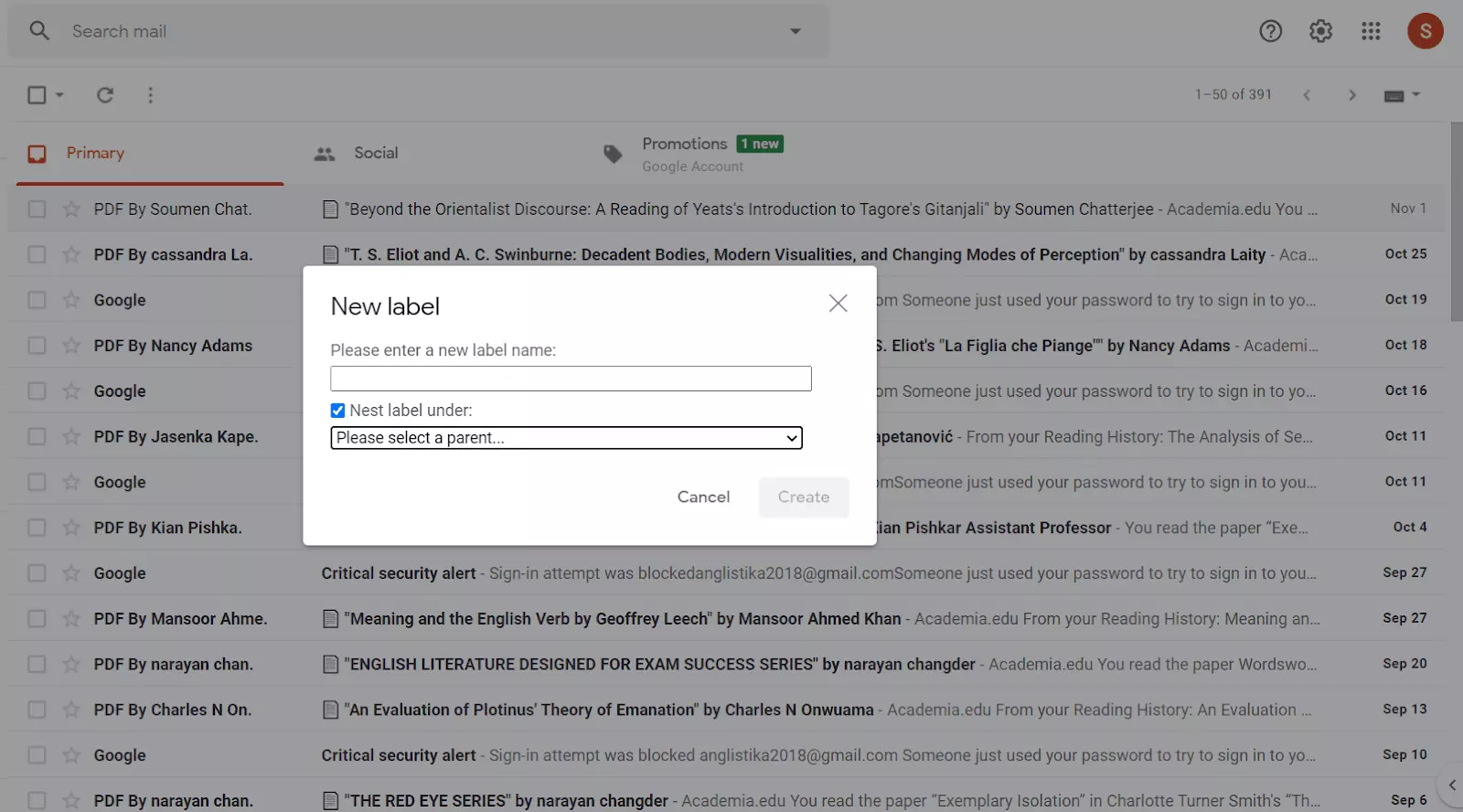
You can convert any existing label into a subfolder through the Manage Labels menu. Navigate to the left sidebar, scroll to the bottom, and click Manage labels.

Select the label you want to modify, click Edit, check the Nest option, and choose a parent label from the dropdown menu.

You can reverse this process and convert a subfolder back into a parent-level label by unchecking the Nest label under option.
Add Labels to a Sent Message
Gmail enables labeling of outgoing messages during the composition process, which is valuable for tracking sent correspondence by category.
Open Gmail and click the Compose button to create a new email message.

After composing your email content, click the three vertical dots in the bottom-right corner of the composition window, select the Label option, and choose your desired categorization label. Then send your email as normal.
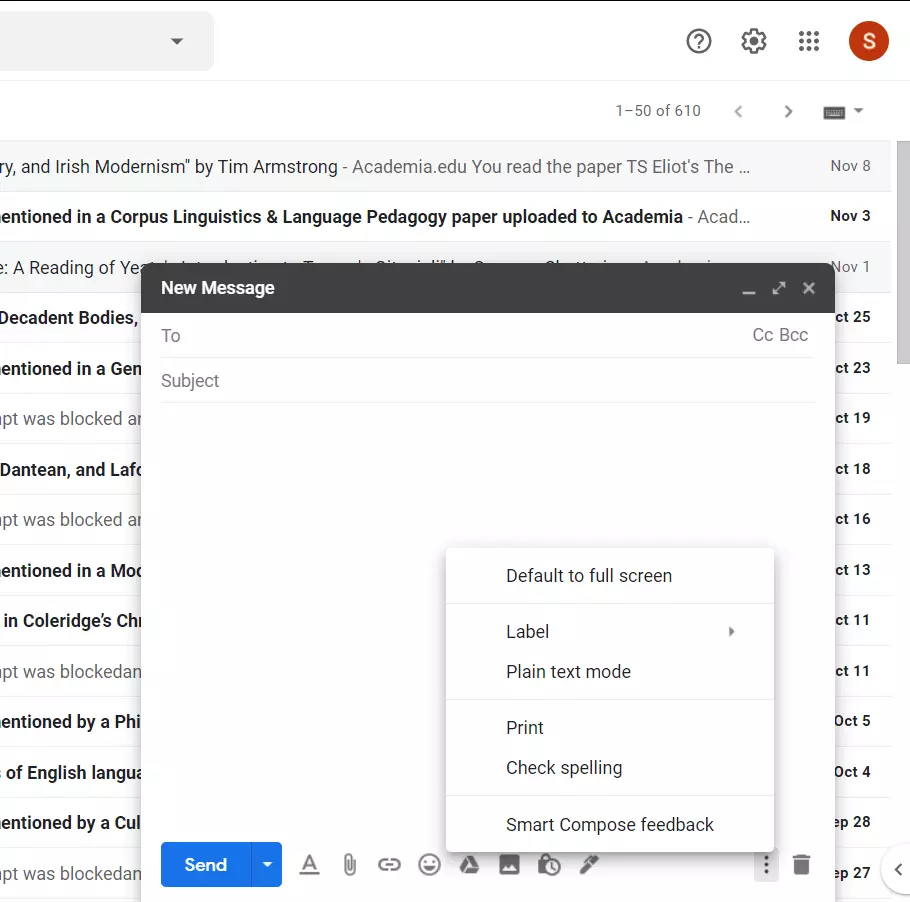
These three methods provide comprehensive approaches to email labeling and organization within Gmail's system.
Organize Your Gmail Correspondence
If you were wondering whether you can create organizational folders in Gmail and systematically manage your messages, the answer is definitively yes through Gmail's sophisticated labeling system!
Gmail doesn't utilize traditional dedicated folder structures; instead, it employs a dynamic labeling system that provides the same organizational functionality with enhanced flexibility. In this comprehensive guide, we've covered two efficient methods for creating Gmail labels and three distinct approaches for applying these labels to organize your email correspondence according to your specific needs.
Maintaining organized email correspondence is crucial for productivity and professional communication. McKinsey research indicates that knowledge workers spend 28% of their workweek managing email, making efficient organization systems essential. Without proper categorization, you'll inevitably face inbox overflow, making it nearly impossible to maintain effective email management. Once you implement a systematic labeling approach, you'll be able to locate specific emails quickly, even months after they were originally received.
While Gmail offers an excellent labeling and organization system, some users require additional advanced features such as unified inbox management or enhanced attachment search capabilities. Email clients such as Mailbird are designed with comprehensive features that enable rapid email discovery, composition, and transmission across multiple accounts.
With Mailbird, you can manage multiple email accounts from a single unified interface while maintaining excellent organizational structure through traditional folder systems. Mailbird also provides advanced attachment search functionality, message snoozing capabilities for time-sensitive correspondence, and seamless integration with productivity applications such as Facebook, Twitter, Dropbox, and Asana.
If you're interested in transforming your email management experience with advanced organizational and productivity features, explore what Mailbird offers for comprehensive email management!
FAQ
Can you create folders in Gmail?
You can't create traditional folders, but you can create labels instead. Labels function identically to folders and allow you to sort and organize your daily email correspondence by grouping messages into different categories.
Why can't I create folders in Gmail?
Gmail uses a labeling system instead of traditional folder structures. Labels provide the same organizational functionality as folders while offering enhanced flexibility, allowing you to keep your inbox organized and clutter-free.
How do I apply multiple labels to an email in Gmail?
To apply multiple labels, open the email, click the Labels button, and select all applicable labels. This allows you to categorize a single email under various topics or categories.
Can I automate the labeling process in Gmail?
Yes, Gmail's filtering system allows you to automate the labeling process based on specific criteria such as sender, keywords, or other search parameters. This helps streamline email organization and reduces manual efforts.
Is it possible to rename labels in Gmail?
Yes, you can rename labels by accessing the Manage Labels section in the settings. Find the label you wish to rename, click Edit, and enter the new name before saving changes.
